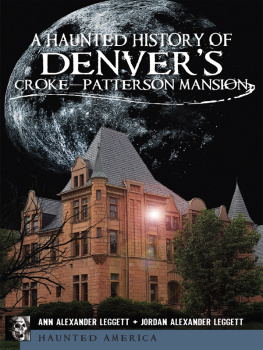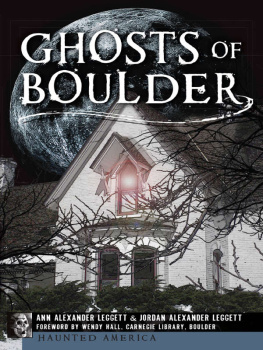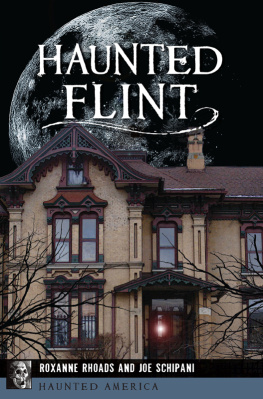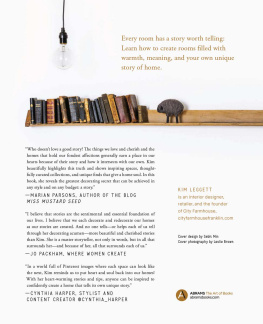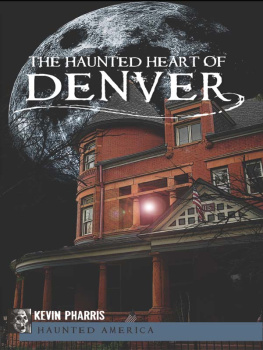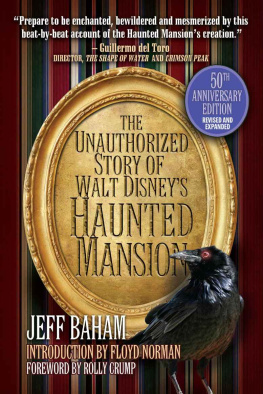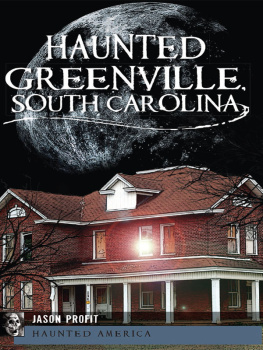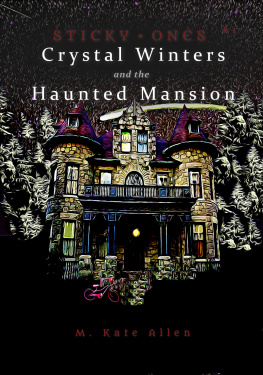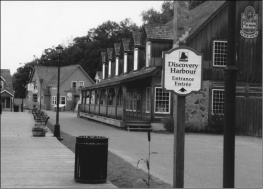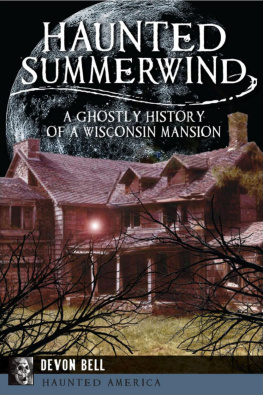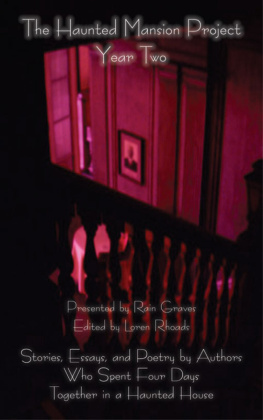
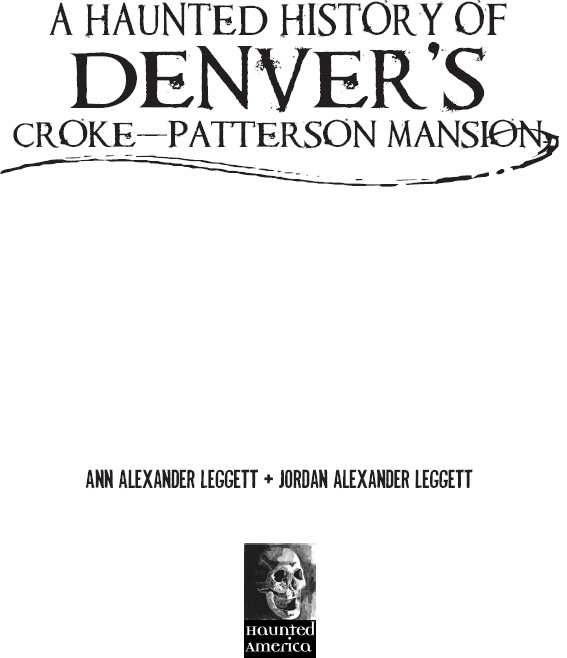
Published by Haunted America
A Division of The History Press
Charleston, SC 29403
www.historypress.net
Copyright 2011 by Ann Alexander Leggett and Jordan Alexander Leggett
All rights reserved
First published 2011
e-book edition 2013
Manufactured in the United States
ISBN 978.1.62584.110.0
Library of Congress Cataloging-in-Publication Data
Leggett, Ann Alexander.
A Haunted History of Denvers Croke-Patterson Mansion / Ann Alexander Leggett and Jordan Alexander Leggett.
p. cm.
Includes bibliographical references.
print edition ISBN 978-1-60949-312-7
1. Haunted houses--Colorado--Denver. 2. Croke-Patterson-Campbell Mansion (Denver, Colo.) I. Leggett, Jordan Alexander. II. Title.
BF1472.U6L444 2011
133.12978883--dc23
2011028514
Notice: The information in this book is true and complete to the best of our knowledge. It is offered without guarantee on the part of the authors or The History Press. The authors and The History Press disclaim all liability in connection with the use of this book.
All rights reserved. No part of this book may be reproduced or transmitted in any form whatsoever without prior written permission from the publisher except in the case of brief quotations embodied in critical articles and reviews.
For Sara and Tom: thanks for the literary gene. We love you.
All houses wherein men have lived and died
Are haunted houses. Through the open doors
The harmless phantoms on their errands glide,
With feet that make no sound upon the floors.
We meet them at the door-way, on the stair,
Along the passages they come and go,
Impalpable impressions on the air,
A sense of something moving to and fro.
There are more guests at table, than the hosts
Invited; the illuminated hall
Is thronged with quiet, inoffensive ghosts,
As silent as the pictures on the wall.
We have no title-deeds to house or lands;
Owners and occupants of earlier dates
From graves forgotten stretch their dusty hands,
And hold in mortmain still their old estates.
So from the world of spirits there descends
A bridge of light, connecting it with this,
Oer whose unsteady floor, that sways and bends,
Wander our thoughts above the dark abyss.
From the poem Haunted Houses, by Henry Wadsworth Longfellow
CONTENTS
FOREWORD
While yet a boy I sought for ghosts, and sped
Through many a listening chamber, cave and ruin,
And starlight wood, with fearful steps pursuing
Hopes of high talk with the departed dead.
Percy Bysshe Shelley, Hymn to Intellectual Beauty
The pursuit of shadows has been with us from the beginning. In Gallups most recent assessment of the role of the paranormal in the human consciousness, nearly 75 percent of Americans professed to have experienced a paranormal event; additionally, close to 40 percent expressed a belief in haunted houses. From every aspect of the human experience, our storytelling traditions have included manifestations to express our fears of the unknown. As a folklorist, I have remained fascinated by such cultural constructions and the way in which, over time, we transmit them. Urban legends, folktales, ghost stories: they all represent the dynamic social interactions between us in the transmission of our folk culture. The collection and preservation of ghost stories serves not only to thrill and terrify on the individual level; their transmission remains a vital and important folkloric legacy of the reflection of a societys collective fears.
Since mankind first began to construct grandiose locales, we have stocked them with our most fantastic nightmares. As early as the first century, the Roman historian Plutarch chronicled the haunting of the great Chaeronean baths by the supposed ghost of a murdered man, whose agonizing shrieks permeated the darkness and forced the closing of the baths by the frightened citizenry. As the polls demonstrate nearly two thousand years later, the ghost story remains as popular as ever. Who cannot recall from childhood the hurried pace as one walked passed a particular house, local bridge or geographical oddity that was never to be visited after sundown? The association of specific locations with evil is, for better or worse, forever part of the human experience. Whether wandering the halls of Elsinore or ravaging the foundations of the House of Usher, such tales have haunted our cultural collective. The history of the Croke-Patterson Mansion is a collection of such stories.
Built in 1890 from the design of the architect Isaac Hodgson, the hauntingly beautiful mansion warrants a volume on the sheer weight of its historical merits alone. Throughout the decades, the house would assimilate the fortunes and fates of some of Colorados most influential families. Later, as the Gilded Age slipped into obscurity, it would bear witness to the mundane travails and tragedies of inhabitants from all walks of life. For many, this historical pedigree should prove enough. Yet in the last three decades, as the splendor of the grand estate fell into disrepair, there arose in its place a most sinister subplot. The Croke-Patterson Mansion has been locked and secured, the name only spoken in hushed tones. The windows no longer regard those looking in but hold the secrets of what may be looking out.
There are many stories about this house, and they are all painstakingly collected for you in this ambitious volume. The stories of the Croke-Patterson are terrible, tragic and often terrifying. In this book, we find some of our most compelling motifs of the haunted house in shocking detail: infanticide, wandering spirits, bodies in the walls and suicidal mothers. Like Plutarch, these authors seek to chronicle them allbefore we forever bar the doors to stop the howling. The most overarching constant in the survival of our folkloric legacy is that we have storytellers to keep it alive. In short, ghost stories can only survive with our willingness to refuse to let them die. Author and researcher Ann Alexander Leggett is made of such stuff.
I first had the pleasure of meeting Ann during my investigation of the alleged haunting of the Macky Auditorium tower at the University of Colorado in Boulder. I was instantly impressed by her dedication to the investigative process, her methodical approach to research and her extraordinary mastery of the storytelling craft. Her weaving of historical fact with regard to folkloric context and journalistic panache sets her apart from the droves of less accomplished authors in the genre. The addition of her daughter and writing partner, the brilliant Jordan Alexander Leggett, has resulted in a text that serves to preserve with equal measure both the natural and supernatural history of the Croke-Patterson Mansion.
My own experience with the mansion occurred last fall in my day (and night) alone in the sprawling structure, assisting the Rocky Mountain Paranormal Research Society with an exhaustive investigation of the supernatural activities attributed to the house. As an academicand of the philosophical bent of my predecessor, the satirical historian Thomas Carlyle (who wisely noted that no ghost was ever seen by two pairs of eyes)my skeptical and scientific nature seemed sure to preclude all fancies of the supernatural. Yet as I wandered the uneven hallways and warped floorboards in the great stillness of utter solitude, I, too, for a brief moment, found it easy to momentarily indulge my own romantic illusions and the fantastical conjurings of the imagination. It was a remarkably easyand remarkably humanpsychological lapse, and one hopefully to be shared, occasionally, by the readers of this book.
Next page
